As a marine enthusiast, I have always been fascinated by the Atlantic Bluefin Tuna, which inhabits the Atlantic Ocean and the Mediterranean Sea. This magnificent fish is known for its size, strength, speed, and delicious taste.
In this article, I will explore the world of the Atlantic Bluefin Tuna, including its anatomy, diet, habitat, lifespan, reproduction, conservation status, and more.
About: Atlantic Bluefin Tuna
| Category | Information |
| Common Names | Atlantic Bluefin Tuna, Northern Bluefin Tuna, Giant Bluefin Tuna |
| Scientific Name | Thunnus thynnus |
| Order | Perciformes |
| Family | Scombridae |
| Diet | Mainly fish such as herring, mackerel, and squid |
| Habitat | Pelagic waters of the Atlantic Ocean |
| Distribution | Found in the western and eastern Atlantic Ocean, as well as the Mediterranean Sea |
| Size | Up to 13 feet |
| Weight | Up to 2000 pounds |
| Speed | Can swim up to 43 miles (70 kilometers) per hour |
| Life Expectancy | Up to 30 years |
| Conservation Status | Endangered due to overfishing and habitat loss |
The Atlantic Bluefin Tuna (Thunnus thynnus) is a large, migratory fish that belongs to the family Scombridae, which includes other tuna species, such as Yellowfin and Albacore. Atlantic Bluefin Tuna is one of the largest tuna species, with an average length of 8 feet and a weight of 1000 pounds. However, some individuals can grow up to 13 feet long and weigh over 2,000 pounds.

The Atlantic Bluefin Tuna has a torpedo-shaped body that is built for speed and endurance. It has two dorsal fins, one with spines and one without. The anal fin is also followed by a series of finlets that help the fish maneuver and maintain balance. The skin of the Atlantic Bluefin Tuna is covered with tiny scales that reduce drag and improve hydrodynamics.
Fun Facts about Atlantic Bluefin Tuna
- Atlantic Bluefin Tuna can swim up to 43 miles per hour.
- The largest Atlantic Bluefin Tuna ever caught weighed 1,496 pounds.
- The Atlantic Bluefin Tuna has been known to migrate over 6,000 miles in a single year.
- The Atlantic Bluefin Tuna is sometimes called the “pig of the sea” due to its rich flavour and texture.
- The Atlantic Bluefin Tuna is a popular sportfish, with many anglers traveling to catch the prized fish.
Anatomy of Atlantic Bluefin Tuna
The Atlantic Bluefin Tuna has a unique anatomy that is designed for life in the open ocean. However, it is complex and consists of various internal and external organs that work together to ensure the survival and functioning of the fish.
External Organs
The Atlantic bluefin tuna’s exterior anatomy is highly intriguing. The Atlantic bluefin tuna’s body is torpedo-shaped and streamlined, allowing it to travel fast through the water. The Atlantic bluefin tuna’s skin is covered in microscopic scales that reduce drag as the fish glides through the water.
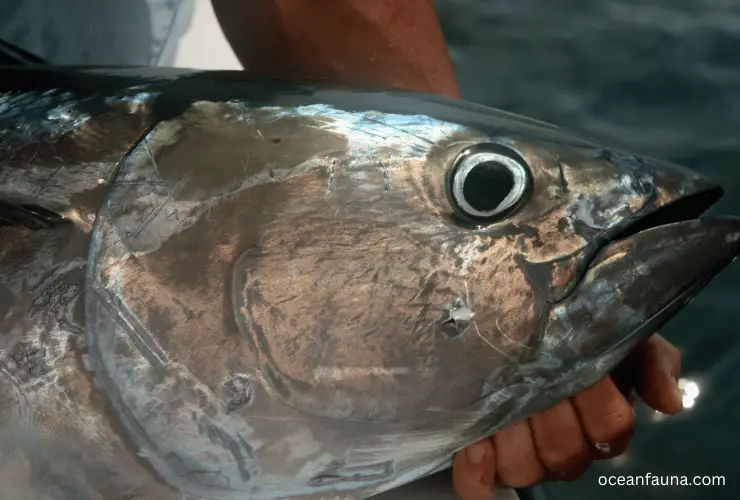
The Atlantic bluefin tuna’s fins are also streamlined, allowing the fish to move fast and efficiently. The dorsal fin is especially broad and powerful, assisting the fish in maintaining its position in the water. The Atlantic bluefin tuna’s tail is also highly distinctive.
Also read: Can Fish See Water? [No, But Why?]
It’s separated into two sections, with the upper section being longer than the lower section. This increases the tuna’s speed and mobility in the water.
Internal Organs
The internal anatomy of the Atlantic bluefin tuna is equally fascinating. The digestive system of the Atlantic bluefin tuna consists of a mouth, esophagus, stomach, and intestines.
The mouth has sharp teeth that allow the fish to catch and eat its prey. The respiratory system of the Atlantic bluefin tuna consists of gills that extract oxygen from the water.
The circulatory system of the Atlantic bluefin tuna is also quite complex. The heart of the Atlantic bluefin tuna is a single-chambered organ that pumps blood throughout the body. The blood of the Atlantic bluefin tuna is unique in that it can maintain a higher temperature than the surrounding water, which helps the fish swim faster and more efficiently.
Where Do Atlantic Bluefin Tuna Live?
Atlantic bluefin tuna are an iconic fish species that inhabit the Atlantic Ocean’s temperate waters. They are incredibly resilient, able to dive to depths of up to 1,000 meters and migrate thousands of miles across vast expanses of ocean.
Atlantic bluefin tuna are found in the northern Atlantic Ocean, primarily off the east coasts of North America and Europe. They also inhabit the Mediterranean Sea, the Black Sea, and the Gulf of Mexico. They have also been found in the southern Atlantic Ocean, off the coast of South America, although their population is much smaller in this region.

Atlantic bluefin tuna migrate across the Atlantic throughout their life cycle, following seasonal temperature changes and the availability of food. They migrate west in the spring to breed in spawning grounds off the coast of North America, then move back east in the summer, with some specimens traveling as far as the Mediterranean Sea.
Atlantic bluefin tuna are generally found near the surface of the ocean, but they can dive to depths of up to 500 to 1000 meters in search of food. They are voracious eaters, feeding on a variety of smaller fish and squid. They have also been known to feed on large and potentially dangerous prey like sharks and whales.
Tagging studies have shown that Atlantic bluefin tuna can migrate across the east/west boundary of the Atlantic. This means that they are able to move rapidly across the ocean, taking advantage of the changing availability of food.
This ability to migrate so quickly and so far is one of the key adaptations that has allowed them to survive and thrive in such an expansive and ever-changing environment.
What Do Atlantic Bluefin Tuna Eat?
Atlantic Bluefin Tuna has a diverse diet that includes a variety of prey species. As opportunistic feeders, they are not picky and will consume almost anything they come across in the water. The Atlantic Bluefin Tuna’s diet changes as they grow and move to different locations, but they primarily feed on small fish, squid, and crustaceans.
Juvenile Atlantic Bluefin Tuna feed on tiny zooplankton, including copepods and krill, and small fish such as mackerel, herring, and sand lance. As they mature, their diet changes to include larger fish such as anchovies, sardines, and mackerel.
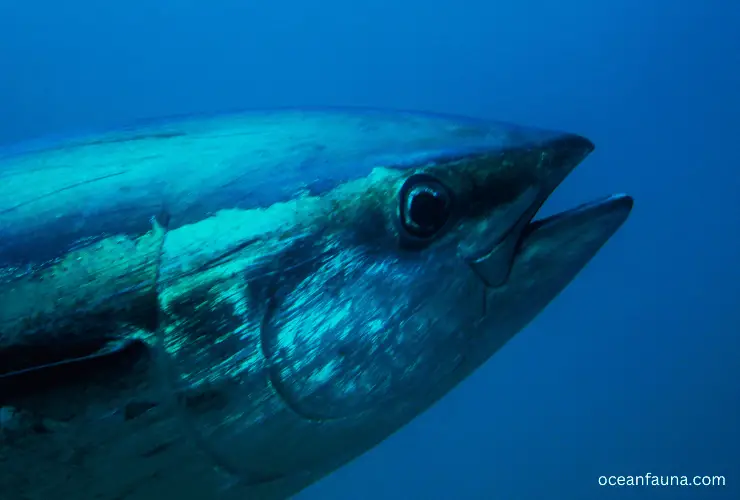
They also consume squid in large quantities as they grow larger. Atlantic Bluefin Tuna are known to consume up to 25% of their body weight per day.
Adult Atlantic Bluefin Tuna primarily feed on larger fish species, such as herring, mackerel, and squid, which are found in the deeper waters of the Atlantic Ocean.
They also eat small crustaceans such as shrimp and crabs. The Atlantic Bluefin Tuna’s diet is influenced by the availability of prey species in their habitat, and they are known to migrate long distances in search of food.
Atlantic Bluefin Tuna is also known to feed on baitfish used in commercial and recreational fishing. This has led to concerns about the impact of overfishing on the Atlantic Bluefin Tuna population. In recent years, efforts have been made to regulate fishing practices and protect the Atlantic Bluefin Tuna population.
What Is the Lifespan of Atlantic Bluefin Tuna?
The Atlantic Bluefin Tuna has a relatively long lifespan compared to other fish species. The average lifespan of the Atlantic Bluefin Tuna is around 15 years, but some individuals can live up to 20-30 years.
The lifespan of the Atlantic Bluefin Tuna depends on various factors, including its size, environment, and fishing pressure.
For example, smaller individuals living in the Atlantic Ocean’s shallower waters tend to have shorter lifespans due to predation and fishing pressure.
On the other hand, larger individuals living in deeper waters are known to live longer due to their greater size and ability to escape predators.
How Do Atlantic Bluefin Tune Reproduce?
The Atlantic Bluefin Tuna reproduces through external fertilization, which means that the eggs and sperm are released into the water. The female Atlantic Bluefin Tuna can produce millions of eggs each year, which the male fertilizes. The fertilized eggs hatch into larvae, which eventually develop into juvenile fish.
Various factors, including temperature, salinity, and food availability, influence the reproduction of the Atlantic Bluefin Tuna. The spawning grounds of the Atlantic Bluefin Tuna are located in the western Mediterranean Sea, the Gulf of Mexico, and the eastern coast of the United States.
It’s worth noting that these fishes are supposed to mature at 8-10 years old. However, in captivity, they reach maturity so fast.
The Fishing Industry and Atlantic Bluefin Tuna
The Atlantic Bluefin Tuna is one of the most valuable fish species in the world, with a market value of up to $200 per pound. The fishing industry for Atlantic Bluefin Tuna is highly lucrative, but it is also controversial due to overfishing and its impact on the species’ population.
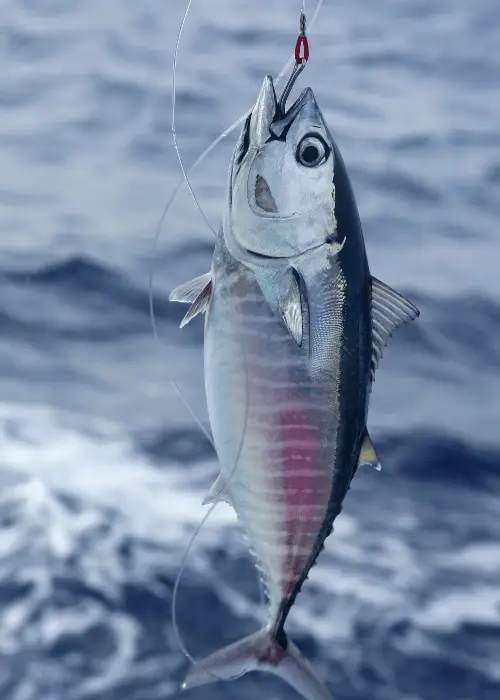
The Atlantic Bluefin Tuna is heavily targeted by commercial and recreational fishermen, which has led to a decline in its population. The fishing industry for Atlantic Bluefin Tuna is regulated by various international agreements, such as the International Commission for the Conservation of Atlantic Tunas (ICCAT), which sets quotas and restrictions on fishing.
Are Atlantic Bluefin Tuna Dangerous to Humans?
Despite their size and reputation as a powerful predator, the Atlantic bluefin tuna poses little danger to humans.
In fact, the vast majority of encounters between humans and Atlantic bluefin tuna occur during fishing activities, and fishermen are much more likely to be injured by the fish than vice versa.
Atlantic bluefin tuna are known for their strength and agility, and they can put up a fierce fight when hooked. Fishermen may be at risk of injury from the fish’s sharp fins and powerful tail, which can cause cuts, bruises, and even broken bones.
While Atlantic bluefin tuna are not typically aggressive toward humans, there have been rare instances of attacks on swimmers, divers, and surfers. These incidents are usually the result of mistaken identity, with the tuna mistaking the human for prey such as a small fish or squid. In such cases, the tuna may bite or strike out with its powerful tail, causing injury or even death.
However, such incidents are extremely rare, and most encounters between humans and Atlantic bluefin tuna are harmless. The fish are generally docile and uninterested in humans and are known to avoid areas of high human activity.
Conservation Status for Atlantic Bluefin Tuna
The Atlantic Bluefin Tuna is currently listed as endangered by the International Union for Conservation of Nature (IUCN). The species is also listed under Appendix I of the Convention on International Trade in Endangered Species of Wild Fauna and Flora (CITES), which means that international trade of the species is prohibited.
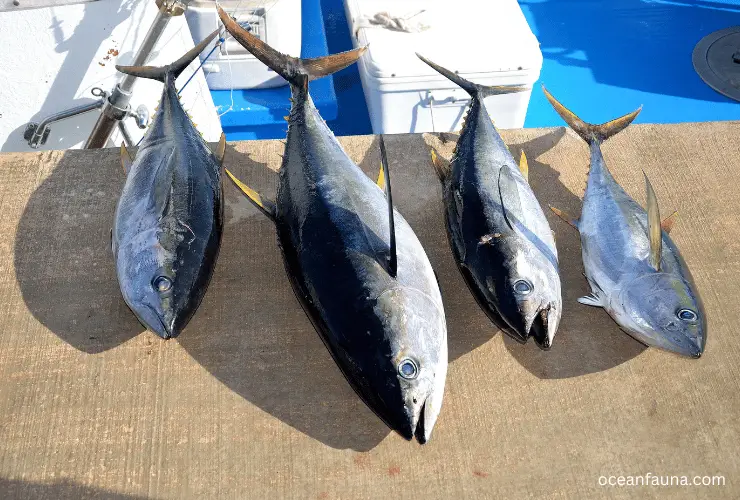
Efforts are being made to conserve and manage the population of Atlantic Bluefin Tuna, including establishing marine protected areas, adopting sustainable fishing practices, and promoting responsible consumption.
Conclusion
The Atlantic Bluefin Tuna is a fascinating and important species that plays a significant role in the marine ecosystem. Its anatomy, diet, habitat, lifespan, and reproduction are all essential aspects of its biology.
The fishing industry for Atlantic Bluefin Tuna is a contentious issue, but efforts are being made to conserve and manage the population of this valuable species. By understanding the world of Atlantic Bluefin Tuna, we can appreciate the beauty and complexity of the ocean and work towards its protection.

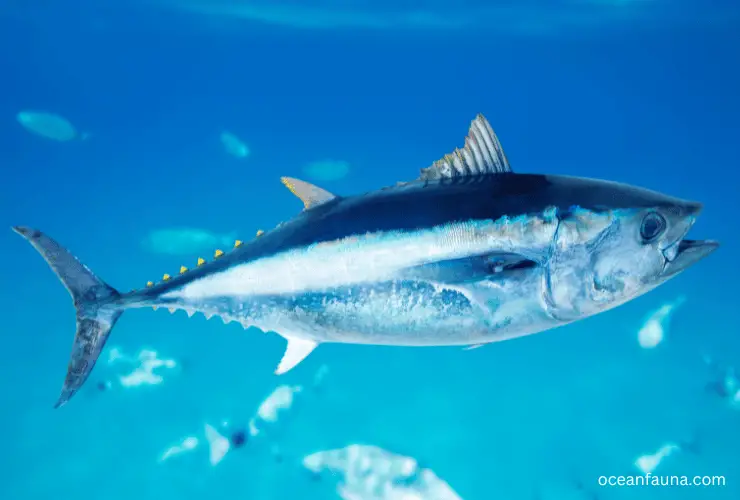
2 thoughts on “Atlantic Bluefin Tuna: Diet, Habitat, Lifespan & Facts”